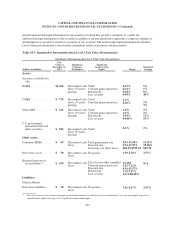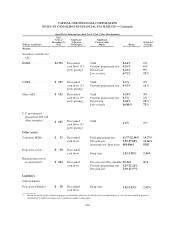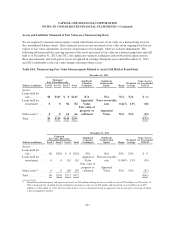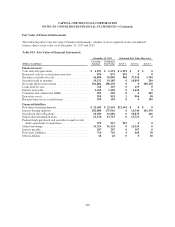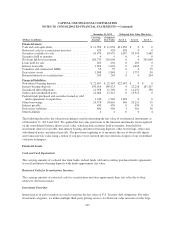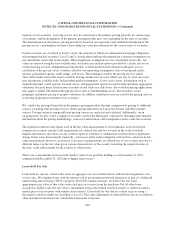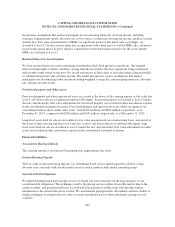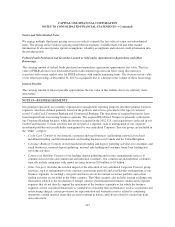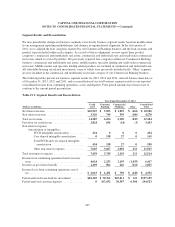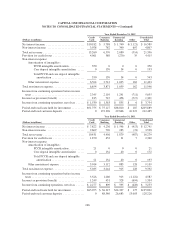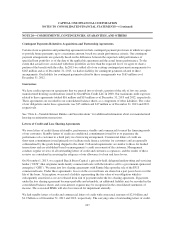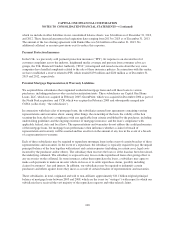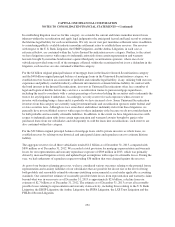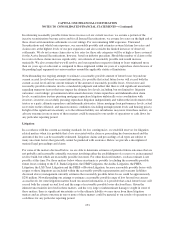Capital One 2013 Annual Report Download - page 264
Download and view the complete annual report
Please find page 264 of the 2013 Capital One annual report below. You can navigate through the pages in the report by either clicking on the pages listed below, or by using the keyword search tool below to find specific information within the annual report.CAPITAL ONE FINANCIAL CORPORATION
NOTES TO CONSOLIDATED FINANCIAL STATEMENTS—(Continued)
Basis of Presentation
We report the results of each of our business segments on a continuing operations basis. See “Note 2—
Discontinued Operations” for a discussion of discontinued operations. The results of our individual businesses
reflect the manner in which management evaluates performance and makes decisions about funding our
operations and allocating resources.
Business Segment Reporting Methodology
The results of our business segments are intended to reflect each segment as if it were a stand-alone business.
Our internal management and reporting process used to derive our segment results employs various allocation
methodologies, including funds transfer pricing, to assign certain balance sheet assets, deposits and other
liabilities and their related revenue and expenses directly or indirectly attributable to each business segment. Our
funds transfer pricing process provides a funds credit for sources of funds, such as deposits generated by our
Consumer Banking and Commercial Banking businesses, and a funds charge for the use of funds by each
segment. Due to the integrated nature of our business segments, estimates and judgments have been made in
allocating certain revenue and expense items. Transactions between segments are based on specific criteria or
approximate third-party rates. We regularly assess the assumptions, methodologies and reporting classifications
used for segment reporting, which may result in the implementation of refinements or changes in future periods.
Following is additional information on the principles and methodologies used in preparing our business segment
results.
•Net interest income: Interest income from loans held for investment and interest expense from deposits and
other interest-bearing liabilities are reflected within each applicable business segment. Because funding and
asset/liability management are managed centrally by our Corporate Treasury Group, net interest income for
our business segments also includes the results of a funds transfer pricing process that is intended to allocate
a cost of funds used or credit for funds provided to all business segment assets and liabilities, respectively,
using a matched funding concept. Also, the taxable-equivalent benefit of tax-exempt products is allocated to
each business unit with a corresponding increase in income tax expense.
•Non-interest income: Non-interest fees and other revenue associated with loans or customers managed by
each business segment and other direct revenues are accounted for within each business segment.
•Provision for credit losses: The provision for credit losses is directly attributable to the business segment in
which the loans are managed.
•Non-interest expense: Non-interest expenses directly managed and incurred by a business segment are
accounted for within each business segment. We allocate certain non-interest expenses indirectly incurred
by business segments, such as corporate support functions, to each business segment based on various
factors, including the actual cost of the services from the service providers, the utilization of the services,
the number of employees or other relevant factors.
•Goodwill and other intangible assets: Goodwill and other intangible assets are assigned to business
segments based on the relative fair value of each segment. Intangible amortization is included in the results
of the applicable segment.
•Income taxes: Income taxes are assessed for each business segment based on a standard tax rate with the
residual tax expense or benefit to arrive at the consolidated effective tax rate included in the “Other”
category.
•Loans held for investment: Loans are reported within each business segment based on product or customer
type.
•Deposits: Deposits are reported within each business segment based on product or customer type.
244



